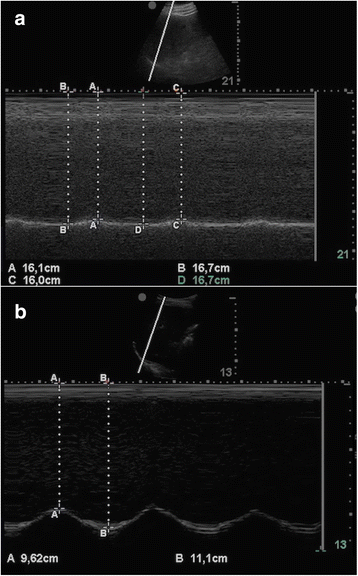Can diaphragmatic ultrasonography performed during the T-tube trial predict weaning failure? The role of diaphragmatic rapid shallow breathing index
- PMID: 27677861
- PMCID: PMC5039882
- DOI: 10.1186/s13054-016-1479-y
Can diaphragmatic ultrasonography performed during the T-tube trial predict weaning failure? The role of diaphragmatic rapid shallow breathing index
Abstract
Background: The rapid shallow breathing index (RSBI), which is the ratio between respiratory rate (RR) and tidal volume (VT), is one of the most widely used indices to predict weaning outcome. Whereas the diaphragm plays a fundamental role in generating VT, in the case of diaphragmatic dysfunction the inspiratory accessory muscles may contribute. If this occurs during a weaning trial, delayed weaning failure is likely since the accessory muscles are more fatigable than the diaphragm. Hence, we hypothesised that the traditional RSBI could be implemented by substituting VT with the ultrasonographic evaluation of diaphragmatic displacement (DD). We named the new index the diaphragmatic-RSBI (D-RSBI). The aim of this study was to compare the ability of the traditional RSBI and D-RSBI to predict weaning failure in ready-to-wean patients.
Methods: We performed a prospective observational study. During a T-tube spontaneous breathing trial (SBT) we simultaneously evaluated right hemidiaphragm displacement (i.e., DD) by using M-mode ultrasonography as well as the RSBI. Outcome of the weaning attempt, length of mechanical ventilation, length of intensive care unit and hospital stay, and hospital mortality were recorded. Receiver operator characteristic (ROC) curves were used to evaluate the diagnostic accuracy of D-RSBI and RSBI.
Results: We enrolled 51 patients requiring mechanical ventilation for more than 48 h who were ready to perform a SBT. Most of the patients, 34 (66 %), were successfully weaned from mechanical ventilation. When considering the 17 patients that failed the weaning attempt, 11 (64 %) had to be reconnected to the ventilator during the SBT, three (18 %) had to be re-intubated within 48 h of extubation, and three (18 %) required non-invasive ventilation support within 48 h of extubation. The areas under the ROC curves for D-RSBI and RSBI were 0.89 and 0.72, respectively (P = 0.006).
Conclusions: D-RSBI (RR/DD) was more accurate than traditional RSBI (RR/VT) in predicting the weaning outcome.
Trial registration: Our clinical trial was retrospectively registered with ClinicalTrials.gov (identifier: NCT02696018 ). ClinicalTrials.gov processed our record on 25 February 2016.
Keywords: Diaphragmatic displacement; Rapid shallow breathing; Spontaneous breathing trial; Ultrasonography; Weaning.
Figures





References
-
- Esteban A, Anzueto A, Frutos F, Alía I, Brochard L, Stewart TE, et al. Mechanical Ventilation International Study Group. Characteristics and outcomes in adult patients receiving mechanical ventilation: a 28-day international study. JAMA. 2002;287(3):345–55. - PubMed
-
- Thille AW, Harrois A, Schortgen F, Brun-Buisson C, Brochard L. Outcomes of extubation failure in medical intensive care unit patients. Crit Care Med. 2011;39(12):2612–8. - PubMed
-
- Vassilakopoulos T, Zakynthinos S, Roussos C. Respiratory muscles and weaning failure. Eur Respir J. 1996;9(11):2383–400. - PubMed
-
- Jubran A, Tobin MJ. Pathophysiologic basis of acute respiratory distress in patients who fail a trial of weaning from mechanical ventilation. Am J Respir Crit Care Med. 1997;155(3):906–15. - PubMed
Associated data
LinkOut - more resources
Full Text Sources
Other Literature Sources
Medical

